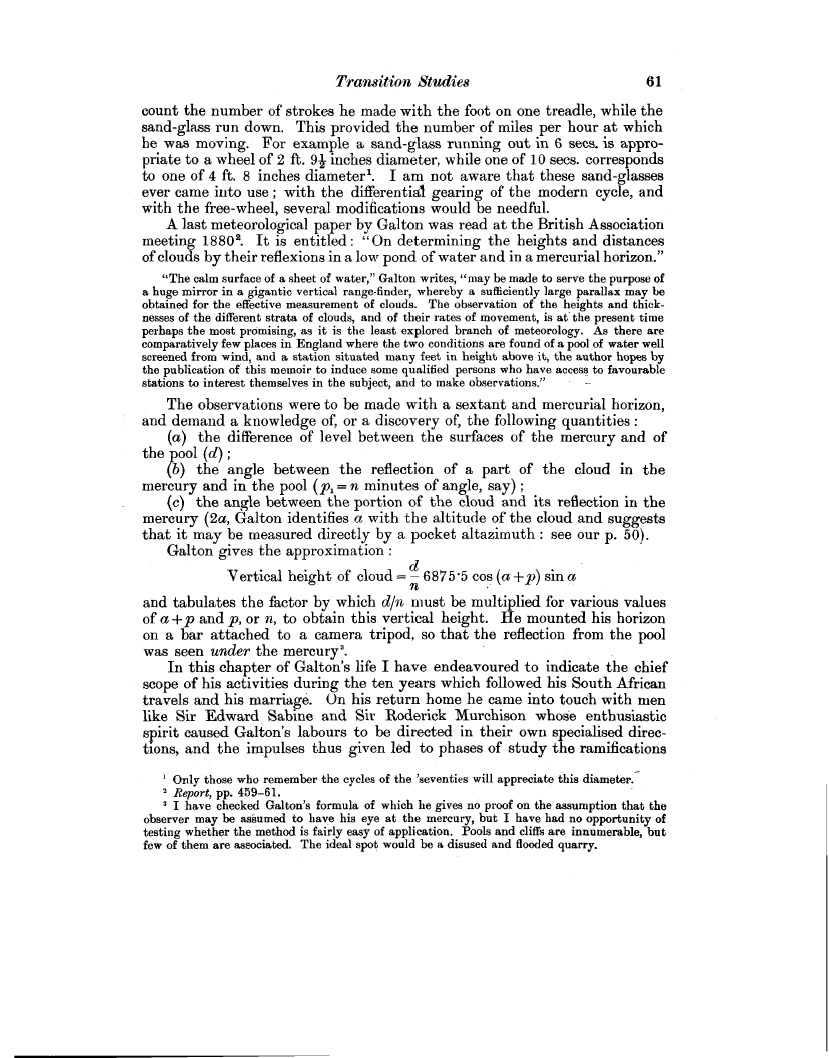Transition Studies 61
count the number of strokes he made with the foot on one treadle, while the sand-glass run down. This provided the number of miles per hour at which he was moving. For example a sand-glass running out in 6 sees. is appropriate to a wheel of 2 ft. 91 inches diameter, while one of 10 sees. corresponds to one of 4 ft. 8 inches diameters. I am not aware that these sand-glasses ever came into use ; with the differential gearing of the modern cycle, and with the free-wheel, several modifications would be needful.
A last meteorological paper by Galton was read at the British Association meeting 18802. It is entitled : "On determining the heights and distances of clouds by their reflexions in a low pond of water and in a mercurial horizon."
"The calm surface of a sheet of water," Galton writes, "may be made to serve the purpose of a huge mirror in a gigantic vertical range-finder, whereby a sufficiently large parallax may be obtained for the effective measurement of clouds. The observation of the heights and thick
nesses of the different strata of clouds, and of their rates of movement, is at the present time perhaps the most promising, as it is the least explored branch of meteorology. As there are comparatively few places in England where the two conditions are found of a pool of water well screened from wind, and a station situated many feet in height above it, the author hopes by the publication of this memoir to induce some qualified persons who have access to favourable
stations to interest themselves in the subject, and to make observations." -
The observations were to be made with a sextant and mercurial horizon, and demand a knowledge of, or a discovery of, the following quantities
(a) the difference of level between the surfaces of the mercury and of the pool (d) ;
(b) the angle between the reflection of a part of the cloud in the mercury and in the pool (p, = n minutes of angle, say) ;
(c) the angle between the portion of the cloud and its reflection in the mercury (2a, Galton identifies a with the altitude of the cloud and suggests that it may be measured directly by a pocket altazimuth : see our p. 50).
Galton gives the approximation
Vertical height of cloud= n 6875.5 cos (a +p) sin a
and tabulates the factor by which d/n must be multiplied for various values of a +p and p, or n, to obtain this vertical height. He mounted his horizon on a bar attached to a camera tripod, so that the reflection from the pool was seen under the mercury'.
In this chapter of Galton's life I have endeavoured to indicate the chief scope of his activities during the ten years which followed his South African travels and his marriage. On his return home he came into touch with men like Sir Edward Sabine and Sir Roderick Murchison whose enthusiastic spirit caused Galton's labours to be directed in their own specialised directions, and the impulses thus given led to phases of study the ramifications
' Only those who remember the cycles of the 'seventies will appreciate this diameter.
2 Report, pp. 459-61.
3 I have checked Galton's formula of which he gives no proof on the assumption that the
observer may be assumed to have his eye at the mercury, but I have had no opportunity of
testing whether the method is fairly easy of application. Pools and cliffs are innumerable, but
few of them are associated. The ideal spot would be a disused and flooded quarry.

